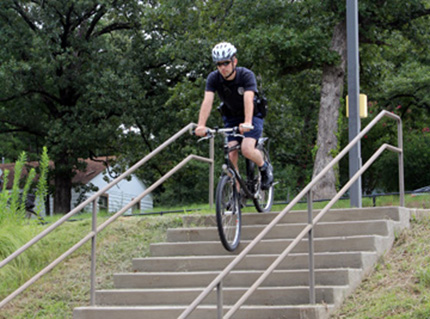UALR debuts bicycle patrols this fall
UALR students and employees came back to campus this week with a special treat: law enforcement officers on bicycle patrol, making officers more accessible in areas cars can’t patrol.
The objective is to reinforce relationships between the campus community and the department, according to UALR Chief of Police Ed Smith.
“The point is to decentralize our operations so that we will more visible and accessible, with an objective to better position ourselves to respond quickly to the needs of our campus community,” said Smith.
He said the bike patrols are part of a larger initiative that will include the eventual opening of several new university police substations throughout the campus, starting with a substation in the Donaghey Student Center.
“In addition to the new bicycle patrol, the other initiative includes encouraging officers to engage in foot patrol, which has proven to be invaluable in community policing efforts,” Smith said.
Over summer break, four officers were trained for the new bicycle patrol under the guidance of Lt. Johnny Smith, who himself trained at a two-week course given by the International Bicycle Association.
Officers Jessica Cazabat, Cody Jones, Justin Davison, and Tanner Peck finished their last day of training Friday, Aug. 16, before tackling their new assignments on the first day of classes, Monday, Aug. 19.
Cazabat said she believed the bike patrols would go far in establishing “open lines of communication” between the officers and the campus family.
Jones agreed, saying, “There seemed to be a disconnect sometimes, when we were patrolling from the car. This way, we are much more accessible.”
According to campussafetymagazine.com, other bonuses of bicycle patrols include:
• More than twice as many contacts with the public than vehicle patrols. These positive contacts help counter stereotypes of police officers as “out to get” the students or others on campus.
• Bicycle patrol officers quickly transition to more service-oriented work.
• Perpetrators don’t notice bike patrols: Individuals who break the law normally are not looking for bicycle officers.
• Bike patrols can go where traditional patrol vehicles can’t. University campuses are characterized by clusters of buildings with limited vehicle access, constant construction, and events, but a bike can navigate through those things.
• Responding to calls in a motor vehicle can take a great deal of time, and often the car can’t access a remote location or is blocked by pedestrians or other barriers.
• Bicycle officers can use all of their senses to detect illegal activity: Bicycle officers encounter crime as it is happening and can see, hear and even smell clues that lead them to areas where crimes are being committed.
• Cycles have other uses: While essential for community policing initiatives, bike patrols can be integrated into other operations and initiatives. Targeted enforcement, surveillance, traffic enforcement, and public order are just a few ways in which bike officers can be deployed.
• Bicycles cost much less to purchase and maintain than traditional patrol cars. They don’t need gas for operation, nor the full-sized parking spaces required by other vehicles.
• Bikes provide environmental benefits: Because bike patrols run on human power rather than gas, their carbon footprint is much smaller than patrol cars. With zero emissions and less need for pavement, bicycle patrols are an attractive option for campuses with green initiatives.
• Bike patrol officers tend to be healthier and more physically fit, and that goes a long way in combatting jokes about “donut-eating cops.”
